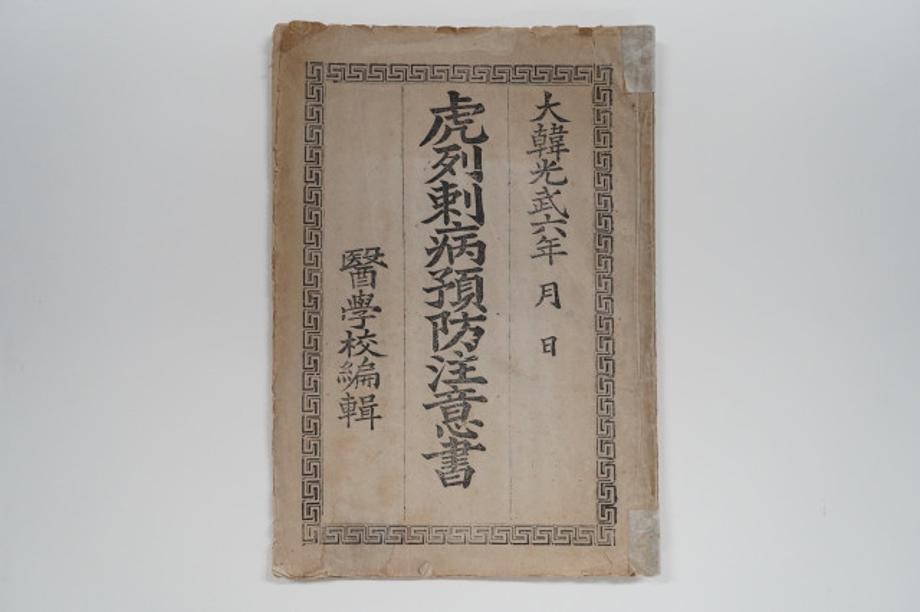아키비움 검색

국가지정 > 국가등록문화유산
호열자병예방주의서
- 한자명虎列刺病豫防注意書
- 영문명Unkonwn
- 지정일/등록일2023-08-10
- 관할시군음성군
- 이칭/별칭국등 848
문화재 설명정보
호열자병예방주의서는 대한제국이 1899년에 설립한 관립의학교에서 1902년 간행한 책자로, 콜레라의 전염과 그 병의 유행 및 예방법, 환자 관리, 소독 방법들을 간략하게 적은 근대 서양의학 기반 전염병 예방서다.
호열자는 콜레라균에 감염돼 발생하는 전염병인 콜레라를 지칭한다. 관립의학교는 1899년 대한제국 정부가 설립한 우리나라 최초의 근대식 의과대학으로, 교육 기간은 3년이며, 총 16과목(동ㆍ식물, 화학, 종두 등)을 정하여 가르쳤다. 약 8년간 운영된 의학교는 1907년 일제 주도하에 설립된 국립병원 대한의원에 흡수되며 문을 닫았다.
호열자병예방주의서는 우리나라 의학과 서지학 발전에 기여한 故김두종 박사(1896~1988)가 기증한 자료다. 음성군 대소면 소재 한독의약박물관에서 소장하고 있는 것이 유일본(有一本)으로, 희소성 측면에서 보존가치가 인정됐다.
이와 함께 호열자병예방주의서는 대한제국기 공중보건 지식 도입 과정과 전염병 방역 활동을 볼 수 있어 의학사적 중요성을 지닌 문화유산으로 그 가치를 인정받아 마침내 국가등록문화재로 등록됐다.
호열자는 콜레라균에 감염돼 발생하는 전염병인 콜레라를 지칭한다. 관립의학교는 1899년 대한제국 정부가 설립한 우리나라 최초의 근대식 의과대학으로, 교육 기간은 3년이며, 총 16과목(동ㆍ식물, 화학, 종두 등)을 정하여 가르쳤다. 약 8년간 운영된 의학교는 1907년 일제 주도하에 설립된 국립병원 대한의원에 흡수되며 문을 닫았다.
호열자병예방주의서는 우리나라 의학과 서지학 발전에 기여한 故김두종 박사(1896~1988)가 기증한 자료다. 음성군 대소면 소재 한독의약박물관에서 소장하고 있는 것이 유일본(有一本)으로, 희소성 측면에서 보존가치가 인정됐다.
이와 함께 호열자병예방주의서는 대한제국기 공중보건 지식 도입 과정과 전염병 방역 활동을 볼 수 있어 의학사적 중요성을 지닌 문화유산으로 그 가치를 인정받아 마침내 국가등록문화재로 등록됐다.
Hoyeoljabyeong yebangjuiseo (Guidelines on the Prevention of Cholera) was published in 1902 by the state-run medical school, which had been established as the country’s first modern medical college by the Korean Empire in 1899. Based on modern Western medicine, this book on the prevention of contagious diseases briefly describes the transmission of cholera, its prevalence, preventive measures, patient care, and methods of disinfection.
The Korean term Hoyeolja refers to cholera, an infection caused by the bacterium Vibrio cholerae. The state-run medical school ran a three-year course comprising sixteen subjects (plants and animals, chemistry, inoculation, etc.). After about eight years, the school was incorporated into Daehan Hospital, a national hospital established under the leadership of Imperial Japan in 1907.
This copy of the book was donated by the late Kim Du-jong (1896-1988), who contributed to the development of Korean medicine and bibliography among other things. Kept at the Handok Museum of Medicine and Pharmacy in Daeso-myeon, Eumseong-gun, Chungcheongbuk-do, it is the only extant copy of Hoyeoljabyeong yebangjuiseo and consequently has been recognized for its excellent state of preservation.
Furthermore, as it explains the process of introducing public health knowledge and contagious disease prevention activities during the Korean Empire, Hoyeoljabyeong yebangjuiseo has been designated as a National Registered Cultural Heritage in recognition of its importance in Korean medical history.
The Korean term Hoyeolja refers to cholera, an infection caused by the bacterium Vibrio cholerae. The state-run medical school ran a three-year course comprising sixteen subjects (plants and animals, chemistry, inoculation, etc.). After about eight years, the school was incorporated into Daehan Hospital, a national hospital established under the leadership of Imperial Japan in 1907.
This copy of the book was donated by the late Kim Du-jong (1896-1988), who contributed to the development of Korean medicine and bibliography among other things. Kept at the Handok Museum of Medicine and Pharmacy in Daeso-myeon, Eumseong-gun, Chungcheongbuk-do, it is the only extant copy of Hoyeoljabyeong yebangjuiseo and consequently has been recognized for its excellent state of preservation.
Furthermore, as it explains the process of introducing public health knowledge and contagious disease prevention activities during the Korean Empire, Hoyeoljabyeong yebangjuiseo has been designated as a National Registered Cultural Heritage in recognition of its importance in Korean medical history.
『虎列刺病予防注意書』は、大韓帝国が1899年に設立した官立医学校から1902年に刊行された冊子で、コレラの伝染、コレラの流行と予防法、患者の管理、消毒方法などを簡略に記した、近代西洋医学に基づいた伝染病予防書である。
虎列刺とは、コレラ菌に感染して発症する伝染病であるコレラのことである。官立医学校は、1899年に大韓帝国政府が設立した韓国初の近代式医科大学であり、教育期間は3年で、全部で16科目(動・植物、化学、種痘など)を教えていた。約8年間運営された医学校は、1907年に日本の主導で設立された国立病院・大韓医院に吸収され閉校した。
『虎列刺病予防注意書』は、韓国の医学と書誌学の発展に貢献した故金斗鐘(キム・ドゥジョン、1896〜1988)博士から寄贈された資料である。陰城郡大所面にある韓独医薬博物館が所蔵しているものが現存する唯一の資料であり、その希少性から保存価値が認められた。
また、『虎列刺病予防注意書』は、大韓帝国時代における公衆保健知識の導入過程や伝染病の防疫活動を知る上で医学史的に重要な文化遺産としてその価値を認められ、国家登録文化遺産にも指定されている。
虎列刺とは、コレラ菌に感染して発症する伝染病であるコレラのことである。官立医学校は、1899年に大韓帝国政府が設立した韓国初の近代式医科大学であり、教育期間は3年で、全部で16科目(動・植物、化学、種痘など)を教えていた。約8年間運営された医学校は、1907年に日本の主導で設立された国立病院・大韓医院に吸収され閉校した。
『虎列刺病予防注意書』は、韓国の医学と書誌学の発展に貢献した故金斗鐘(キム・ドゥジョン、1896〜1988)博士から寄贈された資料である。陰城郡大所面にある韓独医薬博物館が所蔵しているものが現存する唯一の資料であり、その希少性から保存価値が認められた。
また、『虎列刺病予防注意書』は、大韓帝国時代における公衆保健知識の導入過程や伝染病の防疫活動を知る上で医学史的に重要な文化遺産としてその価値を認められ、国家登録文化遺産にも指定されている。
문화유산 상세정보
제 0848 호
국등 848
등록문화재 > 기타 > 동산
보건의료 > 의학도서 > 서양의서
일제강점기
음성군
2023-08-10
-
역사, 문화, 예술, 사회, 경제, 종교, 생활 등 각 분야에서 기념이 되거나 상징적 또는 교육적 가치가 있는 것
-
-
-
-
-
1건
-
대표 소재지 공개
27670충청북도 음성군 대소면 대풍산단로 78
대표 보관장소 공개
27670충청북도 음성군 대소면 대풍산단로 78(한독의약박물관 전시실)/(대풍리)
소유 관리 점유 정보
참고문헌
문화재청, 2023,『국가등록문화유산 등록조사보고서』. [아카이브 > 학술자료 수록]